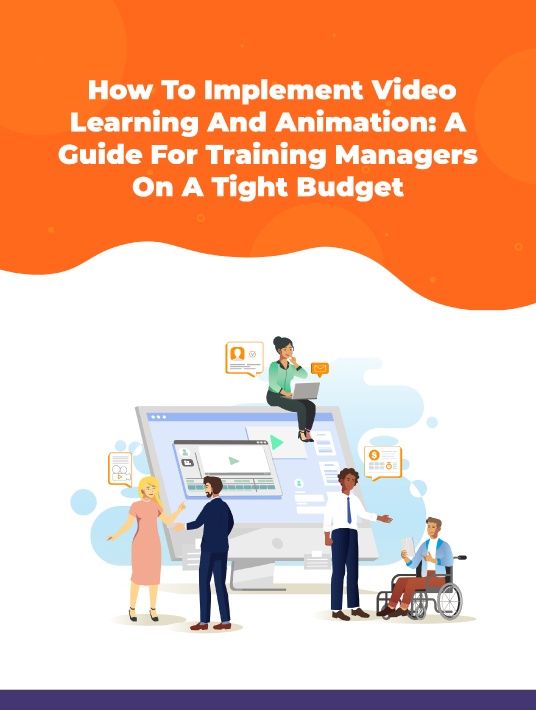eLearning Storyboard Templates To Produce Top Notch Training Video Animations
eLearning animation is quickly becoming a standard part of blended learning programs for corporate entities and big companies looking to educate, retrain, or onboard their staff. Because of its accessibility, convenience, and cost-effective approach, animation has become the clear choice for learning. It offers a simplistic alternative to traditional training methods that many learning and development programs can’t ignore. But before you can create amazing eLearning animated videos, you need a blueprint to ensure that the final product is as informative, entertaining, and clear as you had envisioned it. To do that, you need stellar eLearning storyboard templates.

What Is A Storyboard?
A storyboard is a way to organize the parts of your video graphically. It contains illustrations of the characters or actions that your viewers will see as well as descriptions for the production team and narration or dialogue. It tells the story of your training video in a sequential fashion, highlighting the keyframes that are critical to the animation’s flow.
Storyboards can be as simple or as detailed as necessary to communicate how visuals, audio, and movement will interact.
Why Create A Training Video Animations Storyboard
There are many benefits to creating an eLearning storyboard. While forcing yourself to sit down and outline your ideas is not the most exciting process, it is an effective way to flesh out your story more thoroughly. After all, the first thing you want to do after coming up with an ingenious idea is to share it with others. Unfortunately, it can be hard to explain the amazing things you are visualizing.
With a storyboard, you can explain your eLearning and Microlearning idea with step-by-step tangible visualizations, ensuring that no details get left out in the process. This will also prevent confusion within your team as they work with you to crystallize your vision.
Additionally, a storyboard is great for catching logistical problems with your educational video animation idea. Taking the time to expand and look closely at the dialogue, transitions, and concepts in your head can help reveal inconsistencies or production problems before you begin.
Before You Storyboard
To gather the content you need to begin the storyboarding process, you’ll need to complete a few steps first, starting with your objectives.
Writing out your learning objectives, or drafting a brief for your eLearning animation, will keep you on target when it comes to your learner’s needs and the purpose of the video. Next, you’ll need to draft a simple outline. This outline will help you organize the content of your video more clearly. You can decide what to cut, what to add, or what to expand upon if it’s all laid out plainly.
After the brief and the outline, the next step is scripting. Scripts regularly go through several iterations to get the language, tone, and flow correct. It should feel natural when read and that always takes word-smithing.
Stick with a casual, informative tone when you start writing the script. Even if your organization uses a more formal or conservative tone, you want to be both professional and approachable in your microlearning course. Academic or cerebral writing makes it difficult for learners to understand your content. Fortunately, you can be instructional and informative without putting people to sleep. That means:
- Avoiding jargon.
- Substituting complex words for simple words.
- Writing for a 7th-grade reading level.
- Using short sentences.
But simple language is just the start. If you want learners to really retain and apply the knowledge they gain in your course, add stories to your script. The human brain has a difficult time remembering hard facts, but it’s able to remember stories easily.
The final step before storyboarding is a table read for your script. A table read will allow you, and those on your team, to hear the dialogue and perform one last check for easy to understand language.
Types Of eLearning Storyboards Templates
There are three basic storyboard template types that work for most eLearning and Microlearning animated videos: visual description scripts, printable templates, and photoshop templates.
Visual Description Script Template
The Visual Description Script Template isn’t considered a storyboard in the traditional sense because it doesn’t have any imagery on it. Instead, it’s a numbered table that has a column for audio and a column for visuals. When completing this template, you would paste the dialogue from your script into the audio column and then describe what the viewer would see in the visual column.
This template type is perfect for those who are uncomfortable with storyboarding software and/or have no interest in drawing. It’s also a good place to start when trying to explain your thoughts to a production team. Many animation studios can create a traditional storyboard for you from a visual description script before they start work on the video itself.
Printable Template
The printable template is much more like a traditional storyboard. It’s made up of a series of boxes that represent frames in the video. Below each box is space to add information about dialogue, narration, sound effects, and more.
When filling in this type of video animation template, you’d draw the visuals in the boxes and include notes about audio and/or movement to give your team members a clearer idea of what will be animated as a part of the final product.
Printable templates also make great collaboration tools during production meetings because you can print them, share them with colleagues, and record any notes or feedback they might have directly on the storyboard.
Photoshop Template
A Photoshop Template is the last type. This template type is recommended for the more experienced digital artist. It is similar to the printable template in that it includes drawn visuals, but it stays digital.
With a multi-layered Photoshop file and digital assets, things like version control and color and composition changes are easy to manage. This template also makes presenting the video to an audience, one keyframe at a time, much more practical because it’s as simple as toggling a layer on or off.
Crucial Steps In Creating A Storyboard
Storyboarding can seem challenging if you’re just getting started with eLearning animation but if you follow these 5 steps, you’ll have a product you can be proud of:
1. Brainstorm Ideas
The first thing you will need to do is zero in on a specific idea that seems to best speak to your eLearning Video goals. Chances are, you already have something in mind; however, it may be worth it to spend a few extra minutes to develop and expand your ideas more, either by yourself or with your team.
2. Chart Your Course
At this point, you will need to establish the beginning, middle, and end for your course’s story. On top of a smooth flow and well-thought-out ideas, good stories also have an emotional hook. In adult learning, this is commonly referred to as the “What’s In It For Me?” angle. What about your video will draw your learner in and keep them there?
3. Start Creating
After you have your eLearning video idea well thought out, now the fun part begins! It is time to put your pen, pencil, or cursor to work. Oftentimes, the hardest part of the creation process is taking that first step. Jump in with both feet and don’t worry about perfection. Storyboarding is an iterative process and each storyboard will look different based on the idea it is trying to communicate.
4. Add Details
Once your eLearning course visual ideas are put together on the paper, add in the details that will help your video come to life. eLearning storyboard template details can include arrows indicating motion or adding color.
Conclusion
The last, and most important, step is to revise. No storyboard is ever finished after the first draft. Be sure to consult your subject matter experts, key members of leadership, or people in your target audience for feedback. Think of this step as playtesting your video before it’s complete. The suggestions you get will likely make a stronger final training video animation.
Download the eBook How To Implement Video Learning And Animation: A Guide For Training Managers On A Tight Budget to discover video production best practices and boost learner engagement. Also, join the webinar to leverage the power of micro video-based learning content.

